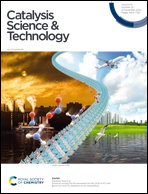Abstract
The ability of halogenated triarylboranes to accept a lone pair of electrons from donor substrates renders them excellent Lewis acids which can be exploited as a powerful tool in organic synthesis. Tris(pentafluorophenyl)borane has successfully demonstrated its ability to act as a metal-free catalyst for an ever-increasing range of organic transformations. Herein we report the N-alkylation reactions of a wide variety of amine substrates including diarylamines, N-methylphenyl amines, and carbazoles with aryl esters using catalytic amounts of B(C6F5)3. This mild reaction protocol gives access to N-alkylated products (35 examples) in good to excellent yields (up to 95%). The construction of a C–N bond at the propargylic position has also been demonstrated to yield synthetically useful propargyl amines. On the other hand, unsubstituted 1H-indoles and 1H-pyrroles at the C3/C2 positions afforded exclusively C–C coupled products. Extensive DFT studies have been employed to understand the mechanism for this transformation.

- This article is part of the themed collection: #RSCPoster Conference


 Please wait while we load your content...
Please wait while we load your content...